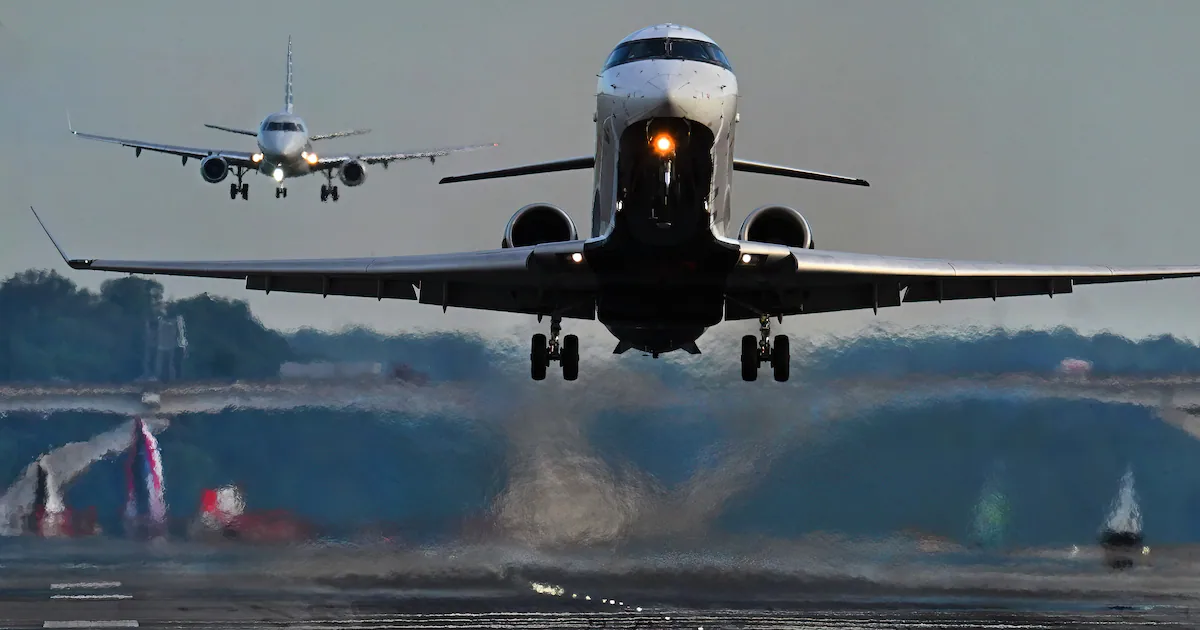Crush of flights routinely strained Reagan National Airport capacity before midair collision

The air traffic controller at Reagan National Airport spoke rapidly, directing the nightly choreography of planes with clipped instructions. “No delay,” he told the pilots of a jetliner preparing to rev its engines for takeoff. Another plane was closing in over the Potomac River and would land on an intersecting runway just 51 seconds later.
At that point on Jan. 29, it was a routine evening rush at the capital’s airport, with arriving airliners scheduled to touch down roughly every two minutes. But what had become routine at National Airport posed serious safety risks, according to publicly released records that include a written warning from the Federal Aviation Administration’s local managers about too many takeoffs and landings.
In the 18 minutes leading up to a midair collision of an Army Black Hawk helicopter and an American Airlines regional jet that night, the air traffic controller managed the movement of 29 separate aircraft, according to a transcript of his communications and investigative findings. During a five-minute span within this period, according to the transcript released by the National Transportation Safety Board, he wove together six airliner departures and arrivals on two runways, while also communicating with four other aircraft.
Now the FAA’s failure to act on warnings that too many planes were being squeezed into the airport has emerged as a crucial focus of investigations into the crash, which killed 67 people. The crescendo of arriving and departing planes during the busiest periods – including a scheduled peak around the time of the crash – reduced the margin of error for air traffic controllers and pilots to dangerous levels, according to a review by The Washington Post of investigative records, FAA documents and testimony gathered by the NTSB.
An internal FAA review following the accident found the airport generally was in “noncompliance” when it came to ensuring adequate distances between planes lining up to land, according to a draft of the review released by the NTSB.
What’s more, political and economic forces perpetuated those busy conditions, according to the frank assessments FAA staffers gave in interviews and testimony gathered by the NTSB. The push by the nation’s largest airlines to deliver millions of passengers a year within a few miles of the halls of power in Washington – using profitable schedules that packed flights into small slices of the day – forced controllers to their limits, the record shows.
In its investigation, NTSB also has gathered statements from air traffic supervisors that American Airlines exploited a weakness in the agency’s rules to create surges in traffic by packing dozens of scheduled flights into 30-minute blocks – a practice that the FAA recently attempted to curtail.
Investigators have not released findings on how the airport’s busy conditions factored into the crash that January evening and are examining multiple possible causes, including the helicopter crew’s apparent failure to see the jetliner and staffing issues in the control tower. They have released an interview transcript with the on-duty air traffic controller, who told them he felt “a little overwhelmed” that night while managing helicopters in addition to airliners.
Much of the NTSB’s evidence was revealed over three days of public hearings in July and August, with families of the victims on the arriving passenger flight from Wichita looking on. Many of those killed were young figure skaters and their parents returning from an event. For Doug Lane, whose wife Christine and 16-year-old son Spencer were killed, it was clear that the volume of traffic and the ensuing burden placed on the controller contributed to the deadly collision.
“It’s just staggering that this is how this works where you have one human playing a juggling act trying to guide hundreds of lives into a busy airport safely,” Lane said. “It’s just shocking to a lay person that this is how it works.”
The FAA did not respond in detail to questions about its oversight of schedules at National. In a statement, it noted that hourly arrival rates have been reduced from 36 to 30 planes since the crash occurred.
The agency was aware that airlines pack schedules within certain portions of an hour, the statement said, adding that it compensates for that by delaying flights “if scheduling could get ahead of the air traffic control capacity.”
The NTSB record shows that the FAA did not act to reduce traffic at peak periods in any systematic way before the crash. In interviews with investigators, frontline staff attributed the agency’s reluctance to “political” pressures from Congress and the airlines.
A formal review launched by the FAA after the crash found that schedules resulted in “over delivery of aircraft” and “non-compliance” on the distance controllers required between aircraft preparing to land, according to a draft of the report. National has limited runway configurations similar to San Diego and Long Beach, in Southern California, and Palm Beach, in Florida, according to the internal review, yet National had arrival rates as much as 50 percent higher than those airports.
American Airlines said in a statement that it is the FAA’s responsibility to set an airport’s arrival rates and that it follows the agency’s scheduling rules. It said it works with FAA officials and made schedule adjustments at National this month at their request, spreading its flights more evenly using 15-minute windows.
Removing helicopters and other noncommercial traffic from the airspace has been the most consequential step taken in the wake of the tragedy to protect passengers, the airline said.
“Safety is always the top priority in everything we do, including the scheduling and execution of our operation,” it said. “Our schedule follows the rules prescribed by the FAA.”
The impact of frequent flights on the control tower was evident the night of the crash, according to the NTSB records. To manage multiple operations in a short period of time, the controller employed several tactics that evolved to manage the high volume of traffic.
To gain precious seconds and separate overlapping arrivals and departures, controllers frequently asked arriving regional jets to land on Runway 33. The shorter auxiliary strip, which is generally too small for larger airliners like a Boeing 737, intersects diagonally with the airport’s main runway. But the approach to Runway 33 crosses within only 15 feet of a designated helicopter route – called Route 4 – along the Potomac River’s eastern bank. That dangerous intersection is the location where the deadly midair crash occurred Jan. 29.
To handle the number of individual aircraft movements in their airspace, controllers frequently shared the burden of avoiding collisions with the helicopter pilots themselves, through a technique called “visual separation,” according to testimony.
That alleviated some of the workload for controllers but shifted part of the responsibility for the safety of arriving jetliner passengers from the National control tower to helicopter cockpits, according to NTSB hearing testimony. The controller on Jan. 29 granted the Black Hawk crew permission to use visual separation moments before the crash.
The accumulated evidence shows that the airport had crossed a line from being merely incredibly busy to “where the amount of traffic creates a risk that is unacceptable,” said Jeff Guzzetti, a former FAA and NTSB safety investigator, in an interview with The Washington Post.
“In my mind, given the amount of arrivals and departures and the staffing and the concerns that were expressed beforehand, that line was crossed,” Guzzetti said. “Someone should have recognized that line was crossed well before the evening of the accident.”
That night, the controller, whom authorities have not identified, was filling two jobs, managing both jet traffic and helicopters. The captain of the last flight to land before the crash said the controller seemed “exceptionally busy.”
Six flights, five minutes
The air traffic controller on duty Jan. 29 when an Army helicopter collided with an American Airlines regional jet managed the movement of 29 aircraft in 18 minutes before the collision occurred at 8:48 p.m., including a stretch of five minutes during which he choreographed six takeoffs and landings.
At moments, the controller confused the call signs of aircraft before correcting himself, according to records. The FAA has acknowledged he failed to alert the arriving American Airlines flight from Wichita to the presence of the Army Black Hawk speeding in its direction.
The controller, in his interview with NTSB investigators, described an ebb and flow of aircraft during the evening.
“The complexity was a mixture of inbound arrivals,” which were traveling at different speeds, he said. “So you’re trying to figure out, okay, how can I get the next departure out before the next arrival. And then you start to have the helicopters.”
The FAA sets arrival rates to manage airport traffic. The rates are not hard limits on the number of flights that can be scheduled for an airport, but FAA rules require them to be regularly reviewed. When an airport operates well above its posted rates, it leaves controllers looking for work-arounds like those being used at National on the night of the crash, said Michael McCormick, a former FAA air traffic control official.
“You have to have controllers that are at the top of their game,” McCormick said. “And when you get controllers who may not be as proficient, then it’s going to start injecting risk.”
Air traffic control managers who worked at the tower and a nearby facility that handles traffic close to National told investigators that in the years before the crash, they had sought to reduce the number of hourly arrivals into the airport, circulating a draft proposal in 2023 to cut the approved rate by four flights an hour – from a maximum of 36 an hour to 32.
The proposal was contained in a memo, written by Bryan Lehman, a traffic manager of an air traffic control facility that feeds flights to National, with support from staff at National’s tower. It argued that the reduction was necessary to “maintain a safe and efficient operation.”
In July, Lehman testified that his manager told them the agency would not pursue the change, citing political considerations on Capitol Hill. The supervisor told him “it was not a good time to address this,” Lehman said.
Since 2000, members of Congress have voted to add 64 daily flights at the airport – about 7.6 percent of National’s roughly 840 flights. Airlines also have shifted to larger planes. The combined result is an airport designed to accommodate 15 million passengers per year that now serves more than 26 million.
Lehman’s memo was drafted as Delta Air Lines was spearheading a coalition pushing to allow more flights into the airport as Congress got to work on a massive bill to set FAA policy for the coming five years. Sen. Ted Cruz (Texas), then the top Republican on the Committee on Commerce, Science and Transportation and a key player in developing the FAA funding bill, was a proponent of adding more flights.
In a statement, a spokesperson for Cruz said: “This tragedy was caused by a helicopter that should have never been flying so close to the airport in the first place.”
According to NTSB investigators, the Army helicopter was flying on an FAA-designated route but above the 200-foot height limit. An investigation later found the aircraft’s barometric altimeter – an instrument that told the pilot and co-pilot how high they were flying – gave measurements 80 to 100 feet lower than the helicopter’s actual altitude during that flight.
Sen. Maria Cantwell (D-Washington), then the committee’s chair and now its top Democrat, did not respond to questions about expanding flights but said in an emailed statement that the NTSB hearings showed frontline staff had “sounded the alarm for years.”
Clark Allen, who was the operations manager at National’s tower at the time of the crash, told investigators the plan to slow arrivals was shot down by more senior FAA management.
“DCA is a very political airport and that was a hot-button issue,” Allen said, referring to National by its airport code. “We were told it is too political, and we were to stand down.”
A Delta spokeswoman said the FAA has the authority to slow traffic and that the carrier works with the agency to ensure safety.
American Airlines and its regional partners account for more than half the flights at the airport. Air traffic control managers told the NTSB that American designed its schedule to pack flights into half-hour blocks – rather than spreading them more evenly over a full hour. Experts said scheduling more tightly in that manner allows airlines to offer faster connections.
American said it schedules flights when people most want to fly but that it would never sacrifice safety. FAA staff mentioned economic incentives in interviews with the NTSB.
“They’re looking at it more as far as revenue, right?” Njuen Mandi Chendi, an FAA air traffic management officer, told NTSB investigators, according to a transcript of the interview. “That’s how they’re scheduling their flights.”
Joshua Gosseling, the operations manager at an air traffic control facility that feeds flights to National, told investigators that rules at the airport limiting the number of airlines’ hourly take-off and landings allowed room for American’s packed schedules in half-hour increments. He said he unsuccessfully recommended to his bosses that the FAA more strictly oversee traffic at the airport.
“The industry is somehow providing enough influence to stop the words from being put on paper,” he told investigators. “Particularly, American Airlines.”
Lehman, who works at the same facility as Gosseling, testified at the NTSB hearings that he did not feel the pressure from American directly, but he told investigators earlier: “No one will stop them.”
“I don’t know how American has this much pull … but it’s a wink-wink that people know what’s going on,” Lehman said.
After the crash, officials sought ways to reduce the risk of another catastrophe. Allen participated in a review that analyzed flight data, a review that proposed a cut in the rate of arrivals at the airport. The shift would not eliminate the risk, but it would lessen it, the review concluded.
The proposal was presented to a larger group that included American Airlines, which Allen said was unhappy. An NTSB investigator asked Allen what feedback the carrier provided.
“They did not like the arrival rate being discussed as a mitigation, and they didn’t believe it should be a mitigation,” Allen said. In response, American reiterated its support of the FAA’s actions to close the helicopter route.
For Lane, whose wife and son were killed, digging into the evidence showed how a thousand small decisions at the airport had piled up before the crash – and had any of them been made differently, the crash might have been avoided.
“There’s hundreds of smoking guns,” he said, “that all fired at the same time.”



